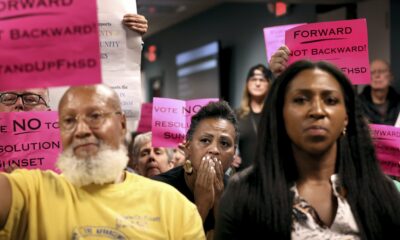Education
Why California's State University Faculty Might Hit the Bricks

Faculty and students from the 23 campuses of the California State University (CSU) system will demonstrate today over a contract fight that they say is critical to the future of higher education in the Golden State. The actions will be highlighted by a march through downtown Long Beach, ending at the state chancellor’s office, where the CSU Board of Trustees is to meet.
The long-running conflict intensified last week, as the California Faculty Association (CFA) announced that 94 percent of its members who voted agreed to authorize a strike. Faculty have been frustrated by what they say is under-investment in teaching: stagnant wages and the CSU’s move towards cheaper part-time teachers rather than tenure-line faculty, while at the same time hiring and giving raises to non-academic supervisors and top management. Student fees increased multiple times over that period. The result, say CFA members, is that students face a tougher path to graduation, while often receiving lower-quality instruction. (Disclosure: The CFA is a financial supporter of Capital & Main.)
“The promise that California has made to its young people is disappearing, and the students that are in school find it harder and harder to get through in a timely way and get the education they need and deserve,” says Preston Rudy, a sociology professor and CFA chapter president at San Jose State University. He adds that the university leadership’s priorities are frustrating faculty and impacting the quality of educators.
“Most galling,” he shares, “is the line that one has to pay ‘market rate’ or higher for presidents and administrators because you can’t find qualified people to do these jobs if you don’t pay them. And meanwhile, I know that many departments are having a hard time recruiting new tenure-line faculty because salaries are low while the cost of living is so high.”
Beginning with the recession, CSU faculty went nearly five years without a raise, before negotiating miniscule wage increases in 2012-13 and a 1.6 percent raise in 2014. Now, with the economy and budget recovering, they are asking for a five percent raise, with an additional 2.65 percent for those in the lowest-paying positions. CSU administrators have offered the same two percent raise they gave to all employees, including themselves. The two sides have now moved to fact-finding – a phase in which both parties present their cases to a mediator — as faculty prepare for a strike that could come as early as January.
When contacted by Capital & Main, CSU spokesperson Toni Molle stated that “CSU values our employees and faculty, and remains committed to the collective bargaining process and achieving a negotiated settlement with the faculty.” Molle pointed out that the system’s two-percent proposal represents a $33 million offer, while “the union is asking for $102.3 million. The gap between the two proposals is $69.3 million and when you add the union’s me-too clauses the gap grows to $107.2million.”
Salaries vary quite a bit between different types of faculty. While professors can start at about $74,000 annually, instructors start at approximately $43,000 – but less for part-timers. The universities’ moves towards nontenure-line and part-timers have been so great that CFA finds more than half its membership earns less than $38,000 per year, a salary well below the self-sufficiency standard on which one can raise a child in most of the state. Many work second jobs or teach extra classes on the side, meaning less-experienced CSU faculty members are often spread thin as their responsibilities, class sizes and roles in teaching increase.
Last November, the CSU Board of Trustees put together a budget that requested $216 million in additional funding from the state – roughly an eight percent increase, which they eventually received from Sacramento. However, their budget plan included only a two percent raise for faculty, the same amount the system remains set on offering a year later.
The budget also earmarked $11 million for hiring new tenure-line faculty, a sum that can fund fewer than 200 full-time equivalent positions. That’s less than a one percent additional increase during a year in which enrollment is expected to rise three percent. A CFA study shows that this continues a trend in which faculty positions have fallen short of enrollment at every CSU campus for more than 10 years.
Earlier this month, CSU’s Toni Molle shrugged off the strike vote, telling the Sacramento Bee, “The strike authorization has now become a routine part of CFA’s post-impasse negotiation strategy.”
However, San Jose State’s Preston Rudy says that’s because the CSU’s executive leadership doesn’t seem to move until faculty take such a step. “In 2007, we had a strike vote and prepared to go out on strike, and [former] Chancellor Reed discovered money at the last minute.”
If a strike is what it takes, Rudy and his colleagues are prepared to go there – as they intend to make clear to the university’s chancellor and trustees in Long Beach today.
-

 California UncoveredApril 9, 2024
California UncoveredApril 9, 2024700,000 Undocumented Californians Recently Became Eligible for Medi-Cal. Many May Be Afraid to Sign Up.
-

 Feet to the FireApril 22, 2024
Feet to the FireApril 22, 2024Regional U.S. Banks Sharply Expand Lending to Oil and Gas Projects
-

 Class WarMarch 26, 2024
Class WarMarch 26, 2024‘They Don’t Want to Teach Black History’
-

 Latest NewsApril 10, 2024
Latest NewsApril 10, 2024The Transatlantic Battle to Stop Methane Gas Exports From South Texas
-

 Latest NewsApril 23, 2024
Latest NewsApril 23, 2024A Whole-Person Approach to Combating Homelessness
-

 Latest NewsMarch 27, 2024
Latest NewsMarch 27, 2024Street Artists Say Graffiti on Abandoned L.A. High-Rises Is Disruptive, Divisive Art
-

 State of InequalityApril 11, 2024
State of InequalityApril 11, 2024Dispelling the Stereotypes About California’s Low-Wage Workers
-

 State of InequalityMarch 28, 2024
State of InequalityMarch 28, 2024Los Angeles Hotel Workers Could Use the 2028 Olympics to Their Advantage




















